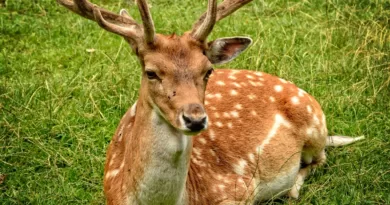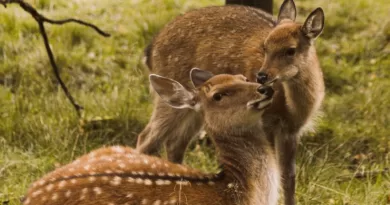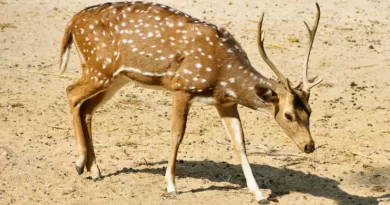What Does It Mean When a Deer Stares at You
Significance of a Deer’s Gaze
The gaze of a deer is not to be taken lightly. It holds a significant meaning that goes beyond mere curiosity or observation. When a deer fixes its eyes upon something, it is a clear indication of intense focus and heightened alertness. It is as if the world around them fades away, and their attention is solely directed towards the object of their gaze. This intense stare is a result of their keen senses and innate survival instincts, which are finely attuned to detect even the slightest signs of danger.
Deer have the ability to detect both movement and sound from great distances, making their gaze a powerful tool for assessing their surroundings. It is through this focused stare that they gather vital information about potential threats or opportunities. Additionally, the deer’s gaze is also a form of communication within their social hierarchy. In a group, the dominant deer will often maintain eye contact with subordinates as a means of asserting their authority and maintaining order. Understanding the significance of a deer’s gaze provides valuable insights into their behavior and allows us to better appreciate their remarkable adaptability in the natural world.
Reasons Behind a Deer’s Intense Stare
The intense stare of a deer has long puzzled researchers and wildlife enthusiasts. There are several reasons why deer display this behavior, each linked to their unique evolutionary traits and survival strategies. Firstly, deer have exceptional vision, allowing them to detect the slightest movement in their surroundings. Their large, wide-set eyes are designed to maximize their field of vision, enabling them to spot predators or potential threats from afar. This heightened awareness contributes to their intense stare as they assess their environment and evaluate potential dangers.
Another reason for a deer’s intense stare is their cautious and curious nature. Deer are known for their exceptional hearing, and they rely on their acute sense of hearing to detect any unfamiliar or suspicious sounds. When deer perceive something unusual, they freeze and direct their attention towards the source of the sound, often staring intently as they try to determine whether it poses a threat. This behavior serves as a survival tactic, allowing them to gather information about their surroundings and make split-second decisions on whether to flee or stay put. The intense stare is an instinctive response that helps them assess the situation and evaluate the level of danger they might face. So, the next time you encounter a deer with an intense stare, remember it’s not just their striking gaze; it’s their way of staying safe and surviving in their natural habitat.
Understanding Deer Behavior
Deer behavior is a fascinating subject that has captivated the attention of researchers for years. These graceful creatures have unique ways of communicating and surviving in their natural habitat. One aspect of deer behavior that has intrigued many is their intense stare.
When a deer fixes its gaze on something or someone, it can be a mesmerizing sight. This behavior is often accompanied by stillness, as if the deer is frozen in time. Many theories have been proposed to explain this behavior, ranging from curiosity to alertness. Understanding the reasons behind a deer’s intense stare can provide valuable insights into their world and help us coexist peacefully with these beautiful creatures.
The Body Language of Deer
When it comes to understanding the behavior of deer, their body language plays a vital role. A deer’s body language is a reflection of their current state of mind and serves as a means of communication within their species. One of the most prominent aspects of a deer’s body language is their intense stare. When a deer fixes its gaze on something, it is not merely a casual glance; instead, it signifies an alert and focused state of being. This intense stare allows them to observe their surroundings and assess potential threats or opportunities.
In addition to their intense stare, deer also use their body posture and movements to communicate. For example, when a deer feels threatened, it may adopt a tense and rigid posture, standing completely still with its ears directed forward. On the other hand, when a deer feels at ease or is engaged in non-aggressive interactions, it may exhibit relaxed body movements, such as gently swishing its tail or grazing peacefully. By paying attention to these subtle cues, we can gain valuable insights into the emotions and intentions of these magnificent creatures.
Decoding Deer Communication
Deer, like many other animals, have a unique way of communicating with each other. Understanding their communication can provide valuable insight into their behavior and the environment they inhabit. One obvious form of communication is through their body language. When a deer stares intensely at something, it is often signaling a state of alertness or curiosity. This prolonged gaze is a way for the deer to assess potential threats or find a source of interest. By carefully observing a deer’s body language, we can begin to decipher their intentions and emotions.
Another way deer communicate is through vocalizations. Although not as common as body language, deer produce a range of sounds to convey different messages. These vocalizations can range from soft bleats to sharp snorts, each carrying its own meaning. For instance, a doe may produce a soft bleat to call her fawns or to indicate her location. On the other hand, a loud snort is often used as an alarm signal, alerting other deer to potential danger. By paying attention to these vocal cues, we can gain a better understanding of the dynamics within a deer population and their responses to various situations.
Instincts and Survival Tactics of Deer
Deer, as prey animals, possess a wide array of instinctual behaviors and survival tactics that aid in their survival in the wild. One of their most notable instincts is their acute sense of hearing. Their large ears act like satellite dishes, capturing even the faintest sounds and alerting them to potential dangers. This heightened sense of hearing allows them to detect the slightest rustle of leaves or snap of a twig, providing them with crucial early warning signals.
In addition to their exceptional hearing, deer also rely heavily on their keen eyesight. Their eyes are strategically positioned on the sides of their heads, giving them a wide field of vision, almost 310 degrees. This evolutionary adaptation enables them to detect threats from various angles, providing them with the opportunity to flee swiftly when necessary. Furthermore, deer have the ability to see colors, making them quite adept at distinguishing between different objects and potential predators.
These survival tactics of deer contribute significantly to their ability to evade danger and ensure their continued existence in their natural habitat. By capitalizing on their sharp senses and employing cautionary behaviors, deer are better equipped to navigate their surroundings and maintain a constant state of alertness. Understanding these instincts is crucial for grasping the underlying reasons behind a deer’s intense stare and decoding their intricate body language.
Factors That Influence a Deer’s Staring
Factors influencing a deer’s staring behavior are diverse and can vary depending on various factors. One common influence that may cause a deer to stare is the presence of a potential threat. Deer have highly sensitive hearing and an acute sense of smell, allowing them to detect predators or danger from a distance. When they sense something unfamiliar or threatening in their environment, their instinct is to freeze and assess the situation. This freeze-and-stare response is often seen as a way for deer to evaluate potential danger and determine the best course of action to ensure their survival.
Another factor that can influence a deer’s staring behavior is their natural curiosity. Deer are known to be curious animals, and they may stare at something that catches their attention out of interest. This could be anything from a sudden movement, a new object in their environment, or even human activity. Curiosity is an innate behavior in deer and can lead them to stare for extended periods as they try to understand and process what they are observing. Additionally, their keen sense of alertness also plays a role in their staring behavior, as they assess their surroundings and remain vigilant to potential threats.
Deer’s Curiosity and Alertness
When it comes to the behavior of deer, their curiosity and alertness play a crucial role in their survival. You may have noticed their intense staring and wondered what it signifies. Well, their curious gaze is a result of their highly evolved senses and instinctual behavior.
Deer are naturally cautious animals, constantly on high alert to potential threats in their surroundings. Their acute hearing and exceptional eyesight allow them to detect even the slightest movement or sound. This heightened awareness grants them an edge in identifying predators or other dangers, ensuring their safety in the wild. As a result, when a deer locks its gaze on something, it is a manifestation of their inquisitive nature, as they assess and evaluate any potential risks or opportunities.
Possible Reactions to a Deer’s Stare
When faced with a deer’s intense stare, it is important to remain calm and avoid making any sudden movements or loud noises. This is because a sudden reaction can startle the deer and potentially put you in danger. Instead, try to maintain a relaxed posture and avoid direct eye contact with the deer. By averting your gaze, you are showing the deer that you pose no threat and are not a predator. It is important to remember that deer are wild animals and their reactions can be unpredictable, so it is crucial to exercise caution and not provoke them in any way.
Another crucial aspect of reacting to a deer’s stare is to give the animal its space. While it may be tempting to approach or try to interact with the deer, it is important to understand that they are wild creatures and prefer to maintain their distance from humans. Getting too close to a deer can cause it stress or anxiety, and may even result in aggression. Instead, appreciate the encounter from a respectful distance and observe the deer from afar. This will not only ensure your safety but also allow the deer to feel more at ease in its natural environment.
Appropriate Ways to React to a Deer’s Staring
As humans, it is important for us to understand how to appropriately react when faced with a deer’s intense gaze. When a deer stares at you, it is crucial to remain calm and avoid sudden movements. Any abrupt action might startle the deer and potentially put you in a dangerous situation. Instead, try to maintain a relaxed posture and slowly back away from the deer. This will demonstrate that you are not a threat and allow the deer to go about its business peacefully.
Another appropriate way to react to a deer’s staring is to give it plenty of space. It is important to remember that deer are wild animals, and their primary objective is to survive. By keeping a considerable distance, you are respecting their territory and allowing them to feel less threatened. In addition, avoid making direct eye contact with the deer, as this can be perceived as a challenge. Instead, divert your gaze to the side while still keeping an eye on the deer’s movements. By showing restraint and giving the deer the space it needs, you are ensuring both your safety and the wellbeing of the animal.
What is the significance of a deer’s gaze?
A deer’s gaze is significant as it can indicate their level of curiosity, alertness, or potential threat perception in their surroundings.
Why do deer stare at humans or other animals?
Deer may stare at humans or other animals as a way to assess potential danger, determine their next course of action, or out of curiosity.
How can understanding deer behavior help when encountering a staring deer?
Understanding deer behavior can help you interpret their intentions and react appropriately, ensuring both your safety and the deer’s well-being.
How can I interpret the body language of a deer?
The body language of a deer, such as stiff posture, raised head, or the direction of their ears, can give you insights into their current state of alertness or potential threat perception.
How do deer communicate with each other?
Deer communicate with each other through a combination of body language, vocalizations, and scent marking.
What instincts and survival tactics do deer rely on?
Deer rely on their instincts and survival tactics, such as freezing in place, running away, or alerting others in the herd, to protect themselves from potential threats.
What factors can influence a deer’s staring behavior?
Various factors like the presence of predators, unfamiliar scents or sounds, previous negative experiences, or the deer’s comfort level with human presence can influence their staring behavior.
Why are deer curious and alert?
Deer are naturally curious and alert due to their need for constant vigilance in order to survive in their environment and avoid potential threats.
What are some possible reactions to a deer’s stare?
Possible reactions to a deer’s stare can include freezing in place, slowly retreating, maintaining eye contact, or making loud noises to deter the deer.
What are appropriate ways to react to a deer’s staring?
Appropriate ways to react to a deer’s staring include giving the deer space, avoiding sudden movements or loud noises, and slowly backing away to allow the deer to resume its normal activities.




